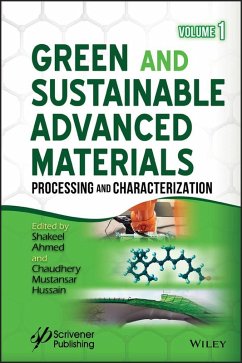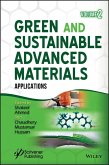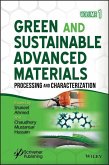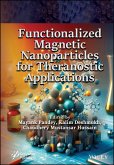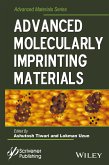Green and Sustainable Advanced Materials, Volume 1 (eBook, ePUB)
Processing and Characterization
Redaktion: Ahmed, Shakeel; Hussain, Chaudhery Mustansar
190,99 €
190,99 €
inkl. MwSt.
Sofort per Download lieferbar

0 °P sammeln
190,99 €
Als Download kaufen

190,99 €
inkl. MwSt.
Sofort per Download lieferbar

0 °P sammeln
Jetzt verschenken
Alle Infos zum eBook verschenken
190,99 €
inkl. MwSt.
Sofort per Download lieferbar
Alle Infos zum eBook verschenken

0 °P sammeln
Green and Sustainable Advanced Materials, Volume 1 (eBook, ePUB)
Processing and Characterization
Redaktion: Ahmed, Shakeel; Hussain, Chaudhery Mustansar
- Format: ePub
- Merkliste
- Auf die Merkliste
- Bewerten Bewerten
- Teilen
- Produkt teilen
- Produkterinnerung
- Produkterinnerung

Bitte loggen Sie sich zunächst in Ihr Kundenkonto ein oder registrieren Sie sich bei
bücher.de, um das eBook-Abo tolino select nutzen zu können.
Hier können Sie sich einloggen
Hier können Sie sich einloggen
Sie sind bereits eingeloggt. Klicken Sie auf 2. tolino select Abo, um fortzufahren.

Bitte loggen Sie sich zunächst in Ihr Kundenkonto ein oder registrieren Sie sich bei bücher.de, um das eBook-Abo tolino select nutzen zu können.
Sustainable development is a very prevalent concept of modern society. This concept has appeared as a critical force in combining a special focus on development and growth by maintaining a balance of using human resources and the ecosystem in which we are living. The development of new and advanced materials is one of the powerful examples in establishing this concept. Green and sustainable advanced materials are the newly synthesized material or existing modified material having superior and special properties. These fulfil today s growing demand for equipment, machines and devices with…mehr
- Geräte: eReader
- mit Kopierschutz
- eBook Hilfe
- Größe: 18.78MB
Andere Kunden interessierten sich auch für
![Green and Sustainable Advanced Materials, Volume 2 (eBook, ePUB) Green and Sustainable Advanced Materials, Volume 2 (eBook, ePUB)]() Green and Sustainable Advanced Materials, Volume 2 (eBook, ePUB)190,99 €
Green and Sustainable Advanced Materials, Volume 2 (eBook, ePUB)190,99 €![Green and Sustainable Advanced Materials, Volume 1 (eBook, PDF) Green and Sustainable Advanced Materials, Volume 1 (eBook, PDF)]() Green and Sustainable Advanced Materials, Volume 1 (eBook, PDF)190,99 €
Green and Sustainable Advanced Materials, Volume 1 (eBook, PDF)190,99 €![Sustainable Nanomaterials for Treatment and Diagnosis of Infectious Diseases (eBook, ePUB) Sustainable Nanomaterials for Treatment and Diagnosis of Infectious Diseases (eBook, ePUB)]() Sustainable Nanomaterials for Treatment and Diagnosis of Infectious Diseases (eBook, ePUB)194,99 €
Sustainable Nanomaterials for Treatment and Diagnosis of Infectious Diseases (eBook, ePUB)194,99 €![Green and Sustainable Advanced Materials, Volume 2 (eBook, PDF) Green and Sustainable Advanced Materials, Volume 2 (eBook, PDF)]() Green and Sustainable Advanced Materials, Volume 2 (eBook, PDF)190,99 €
Green and Sustainable Advanced Materials, Volume 2 (eBook, PDF)190,99 €![Materials, Chemicals and Methods for Dental Applications (eBook, ePUB) Materials, Chemicals and Methods for Dental Applications (eBook, ePUB)]() Johannes Karl FinkMaterials, Chemicals and Methods for Dental Applications (eBook, ePUB)177,99 €
Johannes Karl FinkMaterials, Chemicals and Methods for Dental Applications (eBook, ePUB)177,99 €![Functionalized Magnetic Nanoparticles for Theranostic Applications (eBook, ePUB) Functionalized Magnetic Nanoparticles for Theranostic Applications (eBook, ePUB)]() Functionalized Magnetic Nanoparticles for Theranostic Applications (eBook, ePUB)216,99 €
Functionalized Magnetic Nanoparticles for Theranostic Applications (eBook, ePUB)216,99 €![Advanced Molecularly Imprinting Materials (eBook, ePUB) Advanced Molecularly Imprinting Materials (eBook, ePUB)]() Advanced Molecularly Imprinting Materials (eBook, ePUB)197,99 €
Advanced Molecularly Imprinting Materials (eBook, ePUB)197,99 €-
-
-
Sustainable development is a very prevalent concept of modern society. This concept has appeared as a critical force in combining a special focus on development and growth by maintaining a balance of using human resources and the ecosystem in which we are living. The development of new and advanced materials is one of the powerful examples in establishing this concept. Green and sustainable advanced materials are the newly synthesized material or existing modified material having superior and special properties. These fulfil today s growing demand for equipment, machines and devices with better quality for an extensive range of applications in various sectors such as paper, biomedical, textile, and much more. Volume 1 gives overviews on a variety of topics of characterization of green and sustainable advanced materials including biopolymers, biocomposites, nanomaterials, polymeric materials, green functional textiles materials and hybrid materials, as well as processing chapters on the design and process aspects of nanofabrication.
Dieser Download kann aus rechtlichen Gründen nur mit Rechnungsadresse in D ausgeliefert werden.
Produktdetails
- Produktdetails
- Verlag: John Wiley & Sons
- Erscheinungstermin: 2. Oktober 2018
- Englisch
- ISBN-13: 9781119407379
- Artikelnr.: 54556047
- Verlag: John Wiley & Sons
- Erscheinungstermin: 2. Oktober 2018
- Englisch
- ISBN-13: 9781119407379
- Artikelnr.: 54556047
- Herstellerkennzeichnung Die Herstellerinformationen sind derzeit nicht verfügbar.
Shakeel Ahmed is a Research Fellow at Bio/Polymers Research Laboratory, Department of Chemistry, Jamia Millia Islamia, New Delhi. He obtained his PhD in the area of biopolymers and bionanocomposites. He has published several research publications in the area of green nanomaterials and biopolymers for various applications including biomedical, packaging, sensors, and water treatment. He is an associate member of the Royal Society of Chemistry (RSC), UK and life member of the Asian Polymer Association and Society of Materials Chemistry. Chaudhery Mustansar Hussain, is an Adjunct Professor, an Academic Advisor and Director of Laboratories in the Department of Chemistry & Environmental Sciences at the New Jersey Institute of Technology (NJIT), Newark, New Jersey, USA. Dr. Hussain is the author of numerous papers in peer-reviewed journals as well as a prolific author and editor of several scientific monographs and handbooks in his research areas.
1. Green and Sustainable Advanced Materials: Overview
Tanvir Arfin, Arshiya Tarannum and Kamini Sonawane. 1
1.1. History. 1
1.2. Biomaterials. 2
1.3. CdS. 18
1.4. Carbon Nanotube. 19
1.5. Fe Containing Nanomaterial. 20
1.6. Graphene. 20
1.7. Graphene Oxide. 22
1.8. Inulin. 23
1.9. Pectin. 24
1.10. Metal Oxide. 25
1.11. Polymer. 27
1.12 Bentonite. 29
1.13 Conclusion. 29
References. 30
2. Characterization of Green and Sustainable Advanced Materials. 35
Pintu Pandit and Gayatri T.N.
2.1. Introduction. 36
2.2. Characterization of Advanced Materials. 38
2.3. Physical Characterization of Advanced Materials. 39
2.4. Chemical Characterization of Advanced Materials. 50
2.5. Conclusions. 61
References. 62
3. Green and Sustainable Advanced Biopolymeric and Biocomposite Materials.
67
T.P. Mohan and K. Kanny
3.1. Introduction. 67
3.2. Classification of Green Materials. 68
3.3. Biopolymers. 69
3.4. Natural Fillers. 70
3.5. Natural Fibers. 72
3.6. Biocomposites. 73
3.7. Merits and Demerits of Green Materials. 76
3.8. Recent Progress in Improvement of Material Properties. 78
3.9. Current Applications of Biocomposites and Biopolymers. 79
3.10. Futuristic Applications of Biocomposites and Biopolymers. 83
3.11. Conclusion. 85
References. 86
4. Green and Sustainable Advanced Nanomaterials. 93
Alaa K. H. Al-Khalaf and Falah H. Hussein
4.1. Introduction. 93
4.2. Applications of Natural NanoOrganic Materials. 100
4.3. Conclusion. 104
References. 105
5. Biogenic Approaches for SiO2 Nanostructures: Exploring the Sustainable
Platform of Nanofabrication. 107
M. Hariram, P. Vishnukumar and S. Vivekanandhan
5.1. Introduction. 108
5.2. Synthesis of SiO2 Nanostructures. 109
5.3. Bio-Mediated Sustainable Processes for SiO2 Nanostructures. 115
5.4. Biogenic SiO2 based Doped, Functionalized and Composite
Nanostructures. 125
5.5. Applications of Bio-fabricated SiO2 Nanoparticles. 129
5.6. Conclusions. 131
Acknowledgements. 132
References. 132
6. Green and Sustainable Advanced Composite Materials. 143
Yahya F. Al-Khafaji and Falah H. Hussein.
6.1. Introduction. 143
6.2. Applications of Polymers. 145
6.3. The Problems of Synthetic Polymers. 145
6.4. Why Biodegradable Polymers. 147
6.5. Biodegradable Polymers. 147
6.6. Copolymers. 147
6.7. Examples of Biodegradable Polymers is Polyesters. 148
6.8. Conclusion. 152
References. 152
7. Design and Processing Aspects of Polymer and Composite Materials. 155
Hafiz M. N. Iqbal, Muhammad Bilal and Tahir Rasheed
7.1. Introduction. 156
7.2. Design and Processing. 158
7.3. Natural Polymers and Their Applied Potentialities. 158
7.4. Synthetic Polymers and Their Applied Potentialities. 169
7.5. Materials-based Biocomposites. 173
7.6. Concluding Remarks and Future Considerations. 179
Conflict of Interest. 180
Acknowledgements. 180
References. 180
8. Seaweed-Based Binder in Wood Composites. 191
Kang Chiang Liew and Nur Syafiqah Nadiah Abdul Ghani
8.1. Introduction. 191
8.2. Methods and Techniques. 193
8.3. Results and Discussion. 195
8.4. Conclusion. 208
References. 209
9. Green and Sustainable Textile Materials Using Natural Resources. 213
Pintu Pandit, Gayatri T.N. and Saptarshi Maiti
9.1. Introduction. 213
9.2. Sustainable Colouration of Textile Materials Using Natural Plant Waste
Resources. 216
9.3. Sustainable Antibacterial Finishing of Textile Materials Using Natural
Waste Resources. 223
9.4. Sustainable UV Protective Textile Materials Using Waste Natural
Resources. 226
9.5. Sustainable Green Flame Retardant Textile Materials Using Natural
Resources. 229
9.6. Sustainable Textile Materials Using Clay as Natural Resources. 243
9.7. Sustainable Application of Aroma Finishing in Textile Materials Using
Natural Resources. 250
9.8. Sustainable Mosquito Repellent Textile Materials Using Natural
Resources. 253
9.9. Conclusion. 256
References. 257
10. Green Engineered Functional Textile Materials. 263
Pravin Chavan, Shahid-ul-Islam, Akbar Ali, Shakeel Ahmed and Javed Sheikh
10.1. Introduction. 263
10.2. Different Finishes Applied onto Textiles: Present Techniques vs.
Green Methods. 266
10.3. Methods of Application of Microcapsules on Textiles. 273
10.4. Release Mechanism of Core Material from Microcapsules. 273
10.5. Chemistry of EO. 273
10.6. Evaluation of Mosquito Repellency. 276
10.7. Aroma Finish. 279
10.8. Conclusion. 282
References. 283
11. Advances in Bio-Nanohybrid Materials. 289
Houda Saad, Pedro Luis de Hoyos, Ezzeddine Srasra, Fatima Charrier-El
Bouhtoury
11.1. Introduction. 289
11.2. Inorganic/Organic Hybrids. 290
11.3. Bio-nanohybrid Materials Based on Clay and Polyphenols. 297
11.4. Conclusions and Perspectives. 323
References. 324
12. Green and Sustainable Selenium Nanoparticles and Their Biotechnological
Applications. 333
MeryamSardar and HammadAlam
12.1. Introduction. 334
12.2. Synthesis of SeNPs. 335
12.3. Biotechnological Applications of SeNPs. 341
12.4. Conclusion. 347
Acknowledgments. 348
References. 348
Index. 000
Tanvir Arfin, Arshiya Tarannum and Kamini Sonawane. 1
1.1. History. 1
1.2. Biomaterials. 2
1.3. CdS. 18
1.4. Carbon Nanotube. 19
1.5. Fe Containing Nanomaterial. 20
1.6. Graphene. 20
1.7. Graphene Oxide. 22
1.8. Inulin. 23
1.9. Pectin. 24
1.10. Metal Oxide. 25
1.11. Polymer. 27
1.12 Bentonite. 29
1.13 Conclusion. 29
References. 30
2. Characterization of Green and Sustainable Advanced Materials. 35
Pintu Pandit and Gayatri T.N.
2.1. Introduction. 36
2.2. Characterization of Advanced Materials. 38
2.3. Physical Characterization of Advanced Materials. 39
2.4. Chemical Characterization of Advanced Materials. 50
2.5. Conclusions. 61
References. 62
3. Green and Sustainable Advanced Biopolymeric and Biocomposite Materials.
67
T.P. Mohan and K. Kanny
3.1. Introduction. 67
3.2. Classification of Green Materials. 68
3.3. Biopolymers. 69
3.4. Natural Fillers. 70
3.5. Natural Fibers. 72
3.6. Biocomposites. 73
3.7. Merits and Demerits of Green Materials. 76
3.8. Recent Progress in Improvement of Material Properties. 78
3.9. Current Applications of Biocomposites and Biopolymers. 79
3.10. Futuristic Applications of Biocomposites and Biopolymers. 83
3.11. Conclusion. 85
References. 86
4. Green and Sustainable Advanced Nanomaterials. 93
Alaa K. H. Al-Khalaf and Falah H. Hussein
4.1. Introduction. 93
4.2. Applications of Natural NanoOrganic Materials. 100
4.3. Conclusion. 104
References. 105
5. Biogenic Approaches for SiO2 Nanostructures: Exploring the Sustainable
Platform of Nanofabrication. 107
M. Hariram, P. Vishnukumar and S. Vivekanandhan
5.1. Introduction. 108
5.2. Synthesis of SiO2 Nanostructures. 109
5.3. Bio-Mediated Sustainable Processes for SiO2 Nanostructures. 115
5.4. Biogenic SiO2 based Doped, Functionalized and Composite
Nanostructures. 125
5.5. Applications of Bio-fabricated SiO2 Nanoparticles. 129
5.6. Conclusions. 131
Acknowledgements. 132
References. 132
6. Green and Sustainable Advanced Composite Materials. 143
Yahya F. Al-Khafaji and Falah H. Hussein.
6.1. Introduction. 143
6.2. Applications of Polymers. 145
6.3. The Problems of Synthetic Polymers. 145
6.4. Why Biodegradable Polymers. 147
6.5. Biodegradable Polymers. 147
6.6. Copolymers. 147
6.7. Examples of Biodegradable Polymers is Polyesters. 148
6.8. Conclusion. 152
References. 152
7. Design and Processing Aspects of Polymer and Composite Materials. 155
Hafiz M. N. Iqbal, Muhammad Bilal and Tahir Rasheed
7.1. Introduction. 156
7.2. Design and Processing. 158
7.3. Natural Polymers and Their Applied Potentialities. 158
7.4. Synthetic Polymers and Their Applied Potentialities. 169
7.5. Materials-based Biocomposites. 173
7.6. Concluding Remarks and Future Considerations. 179
Conflict of Interest. 180
Acknowledgements. 180
References. 180
8. Seaweed-Based Binder in Wood Composites. 191
Kang Chiang Liew and Nur Syafiqah Nadiah Abdul Ghani
8.1. Introduction. 191
8.2. Methods and Techniques. 193
8.3. Results and Discussion. 195
8.4. Conclusion. 208
References. 209
9. Green and Sustainable Textile Materials Using Natural Resources. 213
Pintu Pandit, Gayatri T.N. and Saptarshi Maiti
9.1. Introduction. 213
9.2. Sustainable Colouration of Textile Materials Using Natural Plant Waste
Resources. 216
9.3. Sustainable Antibacterial Finishing of Textile Materials Using Natural
Waste Resources. 223
9.4. Sustainable UV Protective Textile Materials Using Waste Natural
Resources. 226
9.5. Sustainable Green Flame Retardant Textile Materials Using Natural
Resources. 229
9.6. Sustainable Textile Materials Using Clay as Natural Resources. 243
9.7. Sustainable Application of Aroma Finishing in Textile Materials Using
Natural Resources. 250
9.8. Sustainable Mosquito Repellent Textile Materials Using Natural
Resources. 253
9.9. Conclusion. 256
References. 257
10. Green Engineered Functional Textile Materials. 263
Pravin Chavan, Shahid-ul-Islam, Akbar Ali, Shakeel Ahmed and Javed Sheikh
10.1. Introduction. 263
10.2. Different Finishes Applied onto Textiles: Present Techniques vs.
Green Methods. 266
10.3. Methods of Application of Microcapsules on Textiles. 273
10.4. Release Mechanism of Core Material from Microcapsules. 273
10.5. Chemistry of EO. 273
10.6. Evaluation of Mosquito Repellency. 276
10.7. Aroma Finish. 279
10.8. Conclusion. 282
References. 283
11. Advances in Bio-Nanohybrid Materials. 289
Houda Saad, Pedro Luis de Hoyos, Ezzeddine Srasra, Fatima Charrier-El
Bouhtoury
11.1. Introduction. 289
11.2. Inorganic/Organic Hybrids. 290
11.3. Bio-nanohybrid Materials Based on Clay and Polyphenols. 297
11.4. Conclusions and Perspectives. 323
References. 324
12. Green and Sustainable Selenium Nanoparticles and Their Biotechnological
Applications. 333
MeryamSardar and HammadAlam
12.1. Introduction. 334
12.2. Synthesis of SeNPs. 335
12.3. Biotechnological Applications of SeNPs. 341
12.4. Conclusion. 347
Acknowledgments. 348
References. 348
Index. 000
1. Green and Sustainable Advanced Materials: Overview
Tanvir Arfin, Arshiya Tarannum and Kamini Sonawane. 1
1.1. History. 1
1.2. Biomaterials. 2
1.3. CdS. 18
1.4. Carbon Nanotube. 19
1.5. Fe Containing Nanomaterial. 20
1.6. Graphene. 20
1.7. Graphene Oxide. 22
1.8. Inulin. 23
1.9. Pectin. 24
1.10. Metal Oxide. 25
1.11. Polymer. 27
1.12 Bentonite. 29
1.13 Conclusion. 29
References. 30
2. Characterization of Green and Sustainable Advanced Materials. 35
Pintu Pandit and Gayatri T.N.
2.1. Introduction. 36
2.2. Characterization of Advanced Materials. 38
2.3. Physical Characterization of Advanced Materials. 39
2.4. Chemical Characterization of Advanced Materials. 50
2.5. Conclusions. 61
References. 62
3. Green and Sustainable Advanced Biopolymeric and Biocomposite Materials.
67
T.P. Mohan and K. Kanny
3.1. Introduction. 67
3.2. Classification of Green Materials. 68
3.3. Biopolymers. 69
3.4. Natural Fillers. 70
3.5. Natural Fibers. 72
3.6. Biocomposites. 73
3.7. Merits and Demerits of Green Materials. 76
3.8. Recent Progress in Improvement of Material Properties. 78
3.9. Current Applications of Biocomposites and Biopolymers. 79
3.10. Futuristic Applications of Biocomposites and Biopolymers. 83
3.11. Conclusion. 85
References. 86
4. Green and Sustainable Advanced Nanomaterials. 93
Alaa K. H. Al-Khalaf and Falah H. Hussein
4.1. Introduction. 93
4.2. Applications of Natural NanoOrganic Materials. 100
4.3. Conclusion. 104
References. 105
5. Biogenic Approaches for SiO2 Nanostructures: Exploring the Sustainable
Platform of Nanofabrication. 107
M. Hariram, P. Vishnukumar and S. Vivekanandhan
5.1. Introduction. 108
5.2. Synthesis of SiO2 Nanostructures. 109
5.3. Bio-Mediated Sustainable Processes for SiO2 Nanostructures. 115
5.4. Biogenic SiO2 based Doped, Functionalized and Composite
Nanostructures. 125
5.5. Applications of Bio-fabricated SiO2 Nanoparticles. 129
5.6. Conclusions. 131
Acknowledgements. 132
References. 132
6. Green and Sustainable Advanced Composite Materials. 143
Yahya F. Al-Khafaji and Falah H. Hussein.
6.1. Introduction. 143
6.2. Applications of Polymers. 145
6.3. The Problems of Synthetic Polymers. 145
6.4. Why Biodegradable Polymers. 147
6.5. Biodegradable Polymers. 147
6.6. Copolymers. 147
6.7. Examples of Biodegradable Polymers is Polyesters. 148
6.8. Conclusion. 152
References. 152
7. Design and Processing Aspects of Polymer and Composite Materials. 155
Hafiz M. N. Iqbal, Muhammad Bilal and Tahir Rasheed
7.1. Introduction. 156
7.2. Design and Processing. 158
7.3. Natural Polymers and Their Applied Potentialities. 158
7.4. Synthetic Polymers and Their Applied Potentialities. 169
7.5. Materials-based Biocomposites. 173
7.6. Concluding Remarks and Future Considerations. 179
Conflict of Interest. 180
Acknowledgements. 180
References. 180
8. Seaweed-Based Binder in Wood Composites. 191
Kang Chiang Liew and Nur Syafiqah Nadiah Abdul Ghani
8.1. Introduction. 191
8.2. Methods and Techniques. 193
8.3. Results and Discussion. 195
8.4. Conclusion. 208
References. 209
9. Green and Sustainable Textile Materials Using Natural Resources. 213
Pintu Pandit, Gayatri T.N. and Saptarshi Maiti
9.1. Introduction. 213
9.2. Sustainable Colouration of Textile Materials Using Natural Plant Waste
Resources. 216
9.3. Sustainable Antibacterial Finishing of Textile Materials Using Natural
Waste Resources. 223
9.4. Sustainable UV Protective Textile Materials Using Waste Natural
Resources. 226
9.5. Sustainable Green Flame Retardant Textile Materials Using Natural
Resources. 229
9.6. Sustainable Textile Materials Using Clay as Natural Resources. 243
9.7. Sustainable Application of Aroma Finishing in Textile Materials Using
Natural Resources. 250
9.8. Sustainable Mosquito Repellent Textile Materials Using Natural
Resources. 253
9.9. Conclusion. 256
References. 257
10. Green Engineered Functional Textile Materials. 263
Pravin Chavan, Shahid-ul-Islam, Akbar Ali, Shakeel Ahmed and Javed Sheikh
10.1. Introduction. 263
10.2. Different Finishes Applied onto Textiles: Present Techniques vs.
Green Methods. 266
10.3. Methods of Application of Microcapsules on Textiles. 273
10.4. Release Mechanism of Core Material from Microcapsules. 273
10.5. Chemistry of EO. 273
10.6. Evaluation of Mosquito Repellency. 276
10.7. Aroma Finish. 279
10.8. Conclusion. 282
References. 283
11. Advances in Bio-Nanohybrid Materials. 289
Houda Saad, Pedro Luis de Hoyos, Ezzeddine Srasra, Fatima Charrier-El
Bouhtoury
11.1. Introduction. 289
11.2. Inorganic/Organic Hybrids. 290
11.3. Bio-nanohybrid Materials Based on Clay and Polyphenols. 297
11.4. Conclusions and Perspectives. 323
References. 324
12. Green and Sustainable Selenium Nanoparticles and Their Biotechnological
Applications. 333
MeryamSardar and HammadAlam
12.1. Introduction. 334
12.2. Synthesis of SeNPs. 335
12.3. Biotechnological Applications of SeNPs. 341
12.4. Conclusion. 347
Acknowledgments. 348
References. 348
Index. 000
Tanvir Arfin, Arshiya Tarannum and Kamini Sonawane. 1
1.1. History. 1
1.2. Biomaterials. 2
1.3. CdS. 18
1.4. Carbon Nanotube. 19
1.5. Fe Containing Nanomaterial. 20
1.6. Graphene. 20
1.7. Graphene Oxide. 22
1.8. Inulin. 23
1.9. Pectin. 24
1.10. Metal Oxide. 25
1.11. Polymer. 27
1.12 Bentonite. 29
1.13 Conclusion. 29
References. 30
2. Characterization of Green and Sustainable Advanced Materials. 35
Pintu Pandit and Gayatri T.N.
2.1. Introduction. 36
2.2. Characterization of Advanced Materials. 38
2.3. Physical Characterization of Advanced Materials. 39
2.4. Chemical Characterization of Advanced Materials. 50
2.5. Conclusions. 61
References. 62
3. Green and Sustainable Advanced Biopolymeric and Biocomposite Materials.
67
T.P. Mohan and K. Kanny
3.1. Introduction. 67
3.2. Classification of Green Materials. 68
3.3. Biopolymers. 69
3.4. Natural Fillers. 70
3.5. Natural Fibers. 72
3.6. Biocomposites. 73
3.7. Merits and Demerits of Green Materials. 76
3.8. Recent Progress in Improvement of Material Properties. 78
3.9. Current Applications of Biocomposites and Biopolymers. 79
3.10. Futuristic Applications of Biocomposites and Biopolymers. 83
3.11. Conclusion. 85
References. 86
4. Green and Sustainable Advanced Nanomaterials. 93
Alaa K. H. Al-Khalaf and Falah H. Hussein
4.1. Introduction. 93
4.2. Applications of Natural NanoOrganic Materials. 100
4.3. Conclusion. 104
References. 105
5. Biogenic Approaches for SiO2 Nanostructures: Exploring the Sustainable
Platform of Nanofabrication. 107
M. Hariram, P. Vishnukumar and S. Vivekanandhan
5.1. Introduction. 108
5.2. Synthesis of SiO2 Nanostructures. 109
5.3. Bio-Mediated Sustainable Processes for SiO2 Nanostructures. 115
5.4. Biogenic SiO2 based Doped, Functionalized and Composite
Nanostructures. 125
5.5. Applications of Bio-fabricated SiO2 Nanoparticles. 129
5.6. Conclusions. 131
Acknowledgements. 132
References. 132
6. Green and Sustainable Advanced Composite Materials. 143
Yahya F. Al-Khafaji and Falah H. Hussein.
6.1. Introduction. 143
6.2. Applications of Polymers. 145
6.3. The Problems of Synthetic Polymers. 145
6.4. Why Biodegradable Polymers. 147
6.5. Biodegradable Polymers. 147
6.6. Copolymers. 147
6.7. Examples of Biodegradable Polymers is Polyesters. 148
6.8. Conclusion. 152
References. 152
7. Design and Processing Aspects of Polymer and Composite Materials. 155
Hafiz M. N. Iqbal, Muhammad Bilal and Tahir Rasheed
7.1. Introduction. 156
7.2. Design and Processing. 158
7.3. Natural Polymers and Their Applied Potentialities. 158
7.4. Synthetic Polymers and Their Applied Potentialities. 169
7.5. Materials-based Biocomposites. 173
7.6. Concluding Remarks and Future Considerations. 179
Conflict of Interest. 180
Acknowledgements. 180
References. 180
8. Seaweed-Based Binder in Wood Composites. 191
Kang Chiang Liew and Nur Syafiqah Nadiah Abdul Ghani
8.1. Introduction. 191
8.2. Methods and Techniques. 193
8.3. Results and Discussion. 195
8.4. Conclusion. 208
References. 209
9. Green and Sustainable Textile Materials Using Natural Resources. 213
Pintu Pandit, Gayatri T.N. and Saptarshi Maiti
9.1. Introduction. 213
9.2. Sustainable Colouration of Textile Materials Using Natural Plant Waste
Resources. 216
9.3. Sustainable Antibacterial Finishing of Textile Materials Using Natural
Waste Resources. 223
9.4. Sustainable UV Protective Textile Materials Using Waste Natural
Resources. 226
9.5. Sustainable Green Flame Retardant Textile Materials Using Natural
Resources. 229
9.6. Sustainable Textile Materials Using Clay as Natural Resources. 243
9.7. Sustainable Application of Aroma Finishing in Textile Materials Using
Natural Resources. 250
9.8. Sustainable Mosquito Repellent Textile Materials Using Natural
Resources. 253
9.9. Conclusion. 256
References. 257
10. Green Engineered Functional Textile Materials. 263
Pravin Chavan, Shahid-ul-Islam, Akbar Ali, Shakeel Ahmed and Javed Sheikh
10.1. Introduction. 263
10.2. Different Finishes Applied onto Textiles: Present Techniques vs.
Green Methods. 266
10.3. Methods of Application of Microcapsules on Textiles. 273
10.4. Release Mechanism of Core Material from Microcapsules. 273
10.5. Chemistry of EO. 273
10.6. Evaluation of Mosquito Repellency. 276
10.7. Aroma Finish. 279
10.8. Conclusion. 282
References. 283
11. Advances in Bio-Nanohybrid Materials. 289
Houda Saad, Pedro Luis de Hoyos, Ezzeddine Srasra, Fatima Charrier-El
Bouhtoury
11.1. Introduction. 289
11.2. Inorganic/Organic Hybrids. 290
11.3. Bio-nanohybrid Materials Based on Clay and Polyphenols. 297
11.4. Conclusions and Perspectives. 323
References. 324
12. Green and Sustainable Selenium Nanoparticles and Their Biotechnological
Applications. 333
MeryamSardar and HammadAlam
12.1. Introduction. 334
12.2. Synthesis of SeNPs. 335
12.3. Biotechnological Applications of SeNPs. 341
12.4. Conclusion. 347
Acknowledgments. 348
References. 348
Index. 000
